 April/May 2025 - Vol. 38, No. 6.
April/May 2025 - Vol. 38, No. 6.
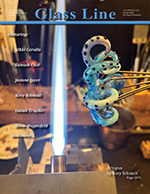
|
In This Issue
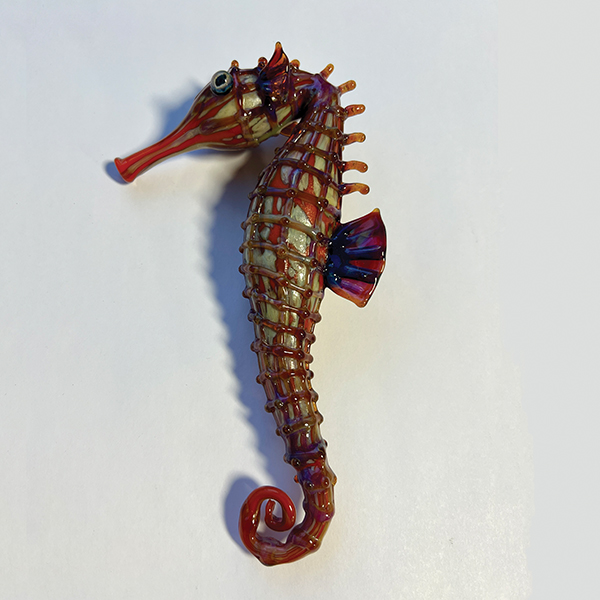
My artistic practice is a deeply personal journey, yet I strive to create work that resonates universally. Each piece reflects my own experiences — navigating cultural transitions, questioning identity, and striving for growth — while offering a way for viewers to project their own aspirations. My sculptures serve as a bridge between personal reflection and collective human experience, reminding us that we are all connected by our desires to grow, achieve, and transcend.
Ultimately, my work is not just about creating objects of beauty but fostering moments of contemplation and connection. I hope to inspire others to reflect on their own dreams, recognize the strength required to pursue them, and embrace the vulnerabilities that come with striving for something greater. By transforming glass into poetic representations of ambition and growth, I aim to create work that is as thought-provoking as it is visually captivating — a testament to the enduring human spirit and its relentless quest for fulfillment...
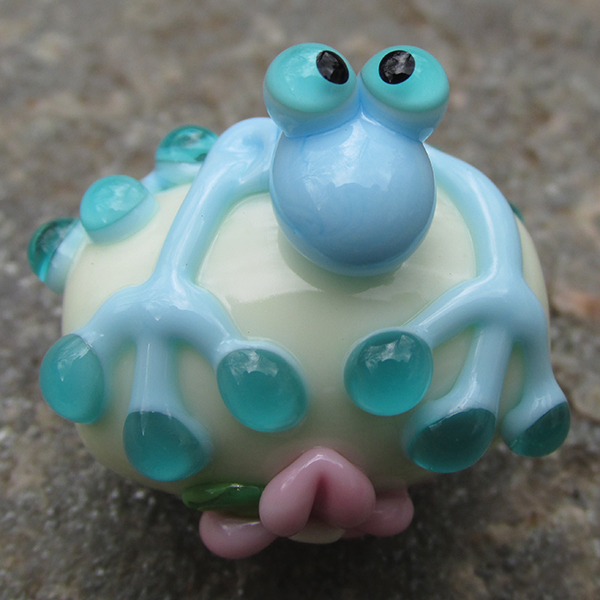
With all sculptural work, think of the viscosity of the glass. White and ivory melt much faster than transparent colors, for example, so they can be a challenge to sculpt at higher heat. If the base bead is soft and the lizard is harder, where they melt together to join could distort the base bead.
Lizards are fun because they can be wound around any shape of bead, with any colors. One technique is to use a mix of short pieces of opaque and transparent glass melted together to create a unique color combo. Olive-shaped beads are a popular lizard perch, but they’ve also been attached to lentils, bones, tubes, and crunched beads.
This technique can be used with any torch, COE, or colors. This example is an olive-shaped bead in a single color, with flowers added afterwars for an additional pop of color...
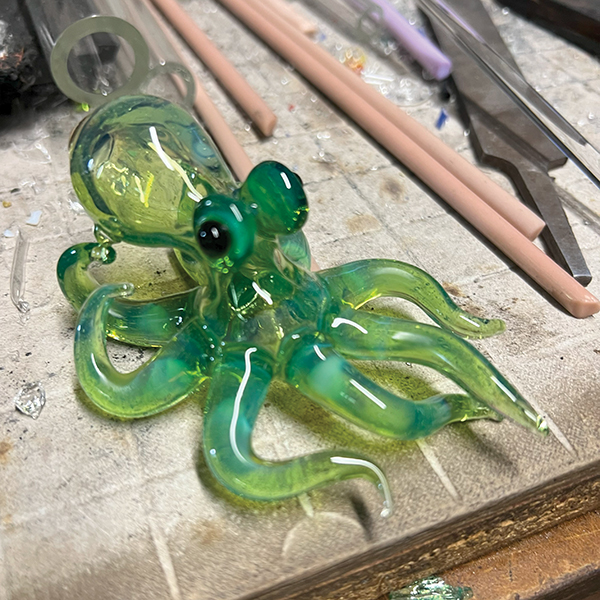
I set up a studio in a front porch area of my house, which got super-cold in the wintertime. I didn’t have a kiln, so a lot of my early work ended up cracking, but learning the process was invaluable. As I continued to progress, I eventually got a new torch, a kiln, and the rest of the tools that make our job easier. Still inspired by animals, I started pushing my personal limits of what I could make out of glass. Some survived, some didn’t, but I learned a lesson with every attempt.
Nowadays, I try to make whatever I am inspired with at the time, whether it’s an animal, figurative or abstract. I try to be a vessel for the art and let it take me in the direction it wants for the day. Some days, it will be an octopus; some days, it will be a character. I like keeping my options open so I can create freely. I still have the ambition of being more creative in the artistic direction, but I am always open to what the future holds for my art. I am inspired by life...
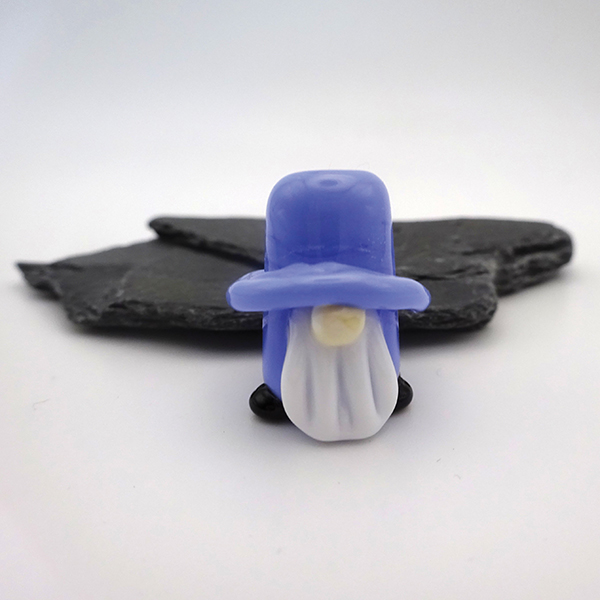
I decided to make a gnome for this tutorial because gnomes are something I love to make. I have lots scattered around my house and garden.
I grew up in a small town called Lancashire in England. My grandfather had a wood workshop where he enjoyed making things and my father was a welder who would also spend time tinkering in his workshop, so I guess I inherited the maker gene. It was my grandfather who started my fascination with glass — when I went to visit him one weekend, he gave me a lump of glass that he had picked up after a local fire. Although it was just a lump of melted clear glass, I was fascinated by it and used it as a paperweight for many years.
I love the process of melting glass and making beads. I also make little figures and have been trying my hand at working off-mandrel...
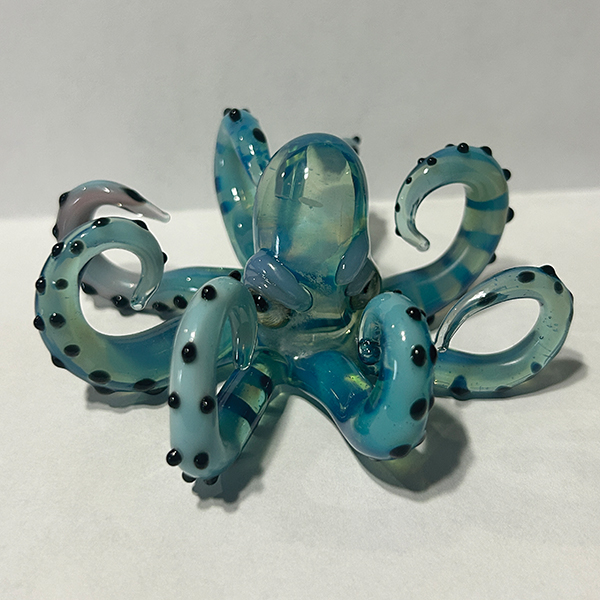
I’ve spent hours, days, weeks, months, and years reading books, watching videos, and honing my skills to the best of my ability. Every piece I make is in loving memory of my father and I have poured every ounce of heart and soul into my art. My story is a true story of blood, sweat, tears, grief, and pure love.
This borosilicate glass octopus is on a more advanced level for artists. It uses some fairly basic techniques for a clear understanding of how it is made. It can be a bit tricky, but has many styles that can be played with by the artist...
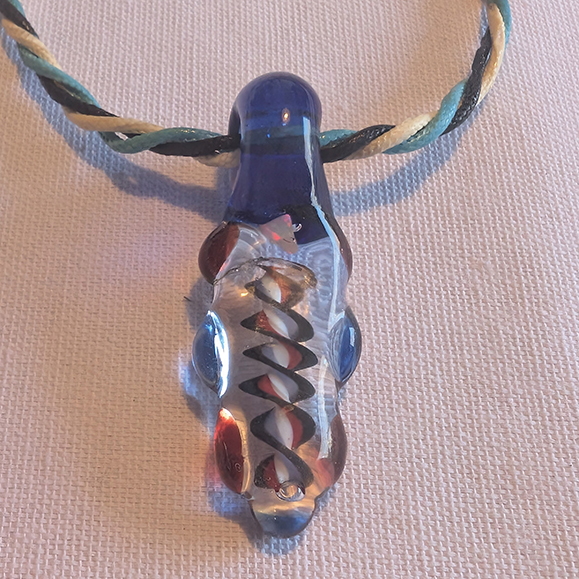
As soon as I built my home studio, my ability to manage my time and how much money I spent on projects improved, as did my skill set. I found that instead of jumping all around on different things due to my attention disorder, I was able to focus in and pay attention to the things that I desired to create. More interesting still, I really started to be able to translate the images in my head into the glass works I was making.
I hope to be going off to school this year at the Salem Community College for Scientific Glass, which is associated with the Corning Glass Museum in Upstate New York. One of my artistic goals is to have pieces that will go into museums in the hopes that I can inspire others, much the way I was inspired by art in profound ways. Art has the ability to transcend the noise of everyday life and provide access to new feelings and thoughts.
This piece is a spearhead-shaped pendant design with a filagree section down the center, near the top...
|
 February/March 2025 - Vol. 38, No. 5.
February/March 2025 - Vol. 38, No. 5.

|
In This Issue
“Starry Night” Cabochon by Yi Zhang
This year, I started a spiritual journey, too. I spend a lot of time mediating and walking in the woods alone. It sparks on lots of fun inspiration. Everything in life — a book, a song, a poem, a vision, a dream — can become an inspiration for my daily art creation. When creating with glass, I can dip myself in the flow. It enlightened me in every way of life, and some of my customers tell me they can feel the love energy from my work. Lately, I find that science, art, and the spiritual come together as a whole. It made me understand that technical, artistic, and inspirational are all equally important in creating glass art. They are all parts of human nature, too ...

I live in France, in La Rochelle, near the sea, and have been a glass artist for more than 10 years now. I like to make colorful little beads. In 2024, I had so much fun in autumn with the pumpkin beads that I decided to provide a tutorial for such beads ...

We bought the old house and did most of the renovations ourselves. We spent days and nights. For the tasks that we couldn’t do ourselves, we called in specialists, carpenters, bricklayers, electricians, and plumbers. We spent two years restoring the house and finally our new Arcos studio was ready. In 2022, we moved our operations to the new studio. Thanks to the efforts of our friends, family, and professionals, our studio turned out beautifully.
Today, I continue to teach glass art and create my own pieces, and my wife takes care of the administrative side.
For me, working with glass is an ongoing journey, full of endless possibilities.
Immersing yourself in this captivating art form requires dedication, love, patience, determination, joy, and never forgetting your dream ...

I have been making glass beads since 1997 and one of my favorite styles of beads are the figural, such as the bear head beads. These beads are wonderful because they can be incorporated into art necklaces with additional beads or simply slid onto a chain or leather cord for a more simplistic look. Learning to make this bead also opens up the opportunity to try your skills on other animal heads because this bead has a base that is also a good starting point for cats, dogs, lions, tigers and so much more ...

I am a lampworker-marine artist, and I make my glass on the shores of the Atlantic Ocean in Aveiro, Portugal. Most of my creations are inspired by the sea.
⠀⠀
In addition to jewelry, I also make waves for interior and Christmas tree toys, so not only individual collectors, but also people’s homes can be filled with the spirit of the ocean and wind.
⠀
I also have a collection of blown glass bubbles, each of which contains one small, happy story. This one is a winter cottage in the colors of the December holiday — red, green, and white — but other colors can be used. Instead of snow, use this tutorial to create a summer meadow, a spring blooming landscape, or a cozy warm house in autumn colors. With free rein of the imagination, a cottage can embody a feeling of warmth and comfort ...

There is nothing quite like this hot and flowing substance. It is such a unique and versatile material. With all the techniques and ways of working, the possibilities are endless. It’s because of this that I chose to dedicate my life to glass. You could spend lifetimes learning new things and still not know everything.
We always had cacti in my house when I was growing up — even a Christmas cactus one year instead of a tree. After making my first cactus in glass and seeing how different it was from other glass objects out there, I knew I needed to do more of them. Over the years, I have developed my own cactus design. This tutorial covers the basics for one of my signature cacti ...
|
 December/January 2024/25 - Vol. 38, No. 4.
December/January 2024/25 - Vol. 38, No. 4.
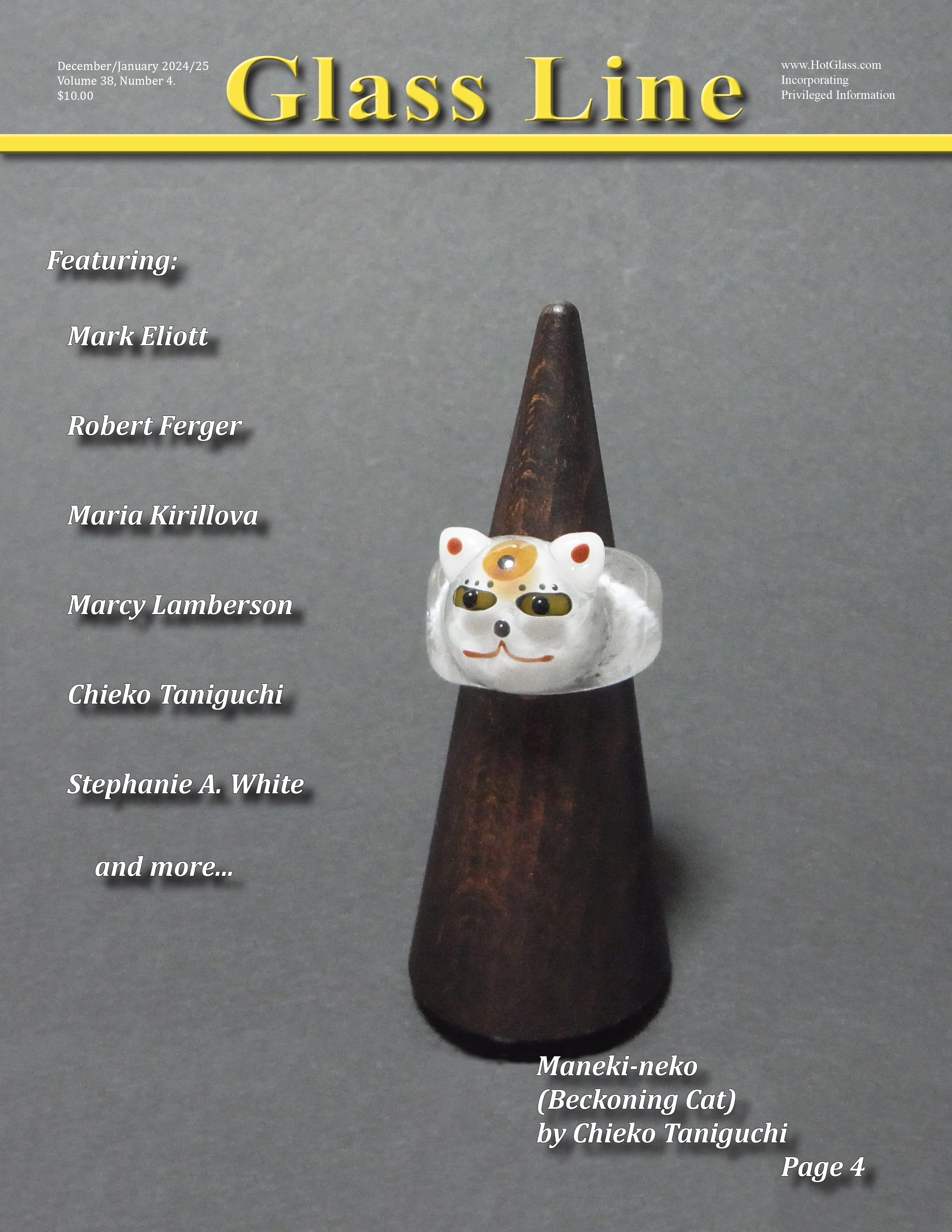
|
In This Issue
Unicorn Head Bead by Marcy Lamberson
I chose this unicorn for a couple of reasons. First, with a simple snip of the shears, it’s possible for what looks like a difficult shaping exercise to turn into a much easier bead. Second, this tutorial also can be adapted to make a favorite horse, or even change it a little more for other animals. And who doesn’t like a touch of whimsy in their lives?

Ever since I started creating, I have wanted to make works that would make people smile. Using both soft glass and borosilicate glass, I make beads and accessories in the shapes of animals that stir my heart.
The overall image of the work is a gentle, soft Japanese atmosphere, but since I used two types of glass with different characteristics. I always try to make the most of the characteristics of each.
This project is a ring made from borosilicate glass. Since 2010, I have been making rings in the shape of various animals, such as polar bears, tigers, and dogs, using easy-to-make colored tubes made with frit.
The motif of this piece is a maneki-neko (beckoning cat). The maneki-neko is a lucky charm unique to Japan. Unlike my other animal rings, I try to make the maneki-neko motif as minimally three-dimensional as possible...

As artists, I encourage you to embrace the things that set you apart. Don’t worry about being able to do what someone else can. The world is constantly crying out for something new, and if you want to bring something new to the world, you have to realize that you can only do that by accepting what makes you unique.
If we don’t love and nurture ourselves and our art, then what does it matter if our bills are paid, if we have a million creative ideas, or if we can master every technique? How we feel truly makes a difference. The most important value you can gain from challenging yourself in your work is your own self-improvement and the growth of your self-esteem.
I encourage you not to compare yourself to anyone but the person you used to be. If you’re growing and improving, don’t discourage yourself by wondering why you’re not doing the same thing as someone else.
Your journey is meant to be exactly as it is, so never take that for granted, or you’ll take the joy out of the process.
Speaking of joy, throw on some Joy to the World, grab your cocoa, and check out this ornament tutorial I whipped up...

I live in Nizhniy Novgorod, Russia. I started lampworking in 2013 after I’d left my office job as an English translator. As a child, I was always attracted to anything handmade and tried different hobbies and activities, but I always believed that I was too clumsy to make something beautiful with my hands and I envied people who could do that.
Then I came to know lampworking. That completely blew my mind and changed my life. Finally, I found a material suitable for my creativity! I was inspired, with thousands of ideas that I wanted to realize. Sometimes I couldn’t even sleep because of that.
I started making glass beads and jewelry. Of course, many people thought I was crazy to leave my office job to do that — but here I am today, 10 years later, still making glass beads. This tutorial is to share my passion for glass, show one of my designs, and show how to make blown-glass beads without needing specific (and often expensive) tools...

I’ve spent a bit of time looking at objects that convey stories such as the work of fellow glass artists Carman Lozar and Tom Moore, or the 18th-century lampworked dioramas of Nevers, France. I’m also interested in art objects that tell religious stories, such as installations in churches and Hindu temples. To me, stories are part of the life-blood of being human and art itself can be seen as a kind of open-ended religion.
My glass clouds are mostly meant to symbolize the gift of moisture, which feeds crops and nurtures all life, rather than clouds of depression or pollution, or those generated by exploding bombs.
Note: All my glass clouds are fully functional — they can be hung from a tree or suspended above a desk as a reminder to sometimes allow the mind to drift into the realm of free improvisation, instead of focusing too hard on the task at hand...

Flower beads are one of my favorite styles to create. There is something enchanting about the intricate designs and vibrant colors that come together to form these beautiful pieces. However, crafting flower beads takes practice. This style can be quite challenging due to the multiple layers and steps required to achieve a perfect balance with clear flowers.
Each flower bead starts with a solid foundation, often made from a base color that enhances the floral design. This is where you can have fun with shimmering gold aventurine, gold mica, pieces of frit, or winding green vines. The process involves carefully and precisely layering different hues to form the petals and stamen. Achieving crisp, clear shapes is crucial, because this detail brings the entire bead to life. Each flower must be balanced in size and proportion to ensure harmony. This meticulous process often involves trial and error as adjustments are made to achieve the desired outcome...
|
 October/November 2024 - Vol. 38, No. 3.
October/November 2024 - Vol. 38, No. 3.
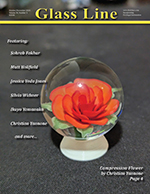
|
In This Issue
Compression Flower by Christian Yannone
Let’s talk about flowers, but more specifically, let’s talk about the colors in the petals and how we achieve them. The first step to playing with color would be to be familiarized with the colors to be blended together independently. The next step is to decide which colors will be used in which order. For this project, the colors will be Cherry, Canary, and OJ. These are three temperamental colors, so be cautious to avoid any boiling during the process...

I strive to expand my horizons, discover new glasses and techniques, and improve my skills by attending workshops with renowned glass artists and networking with like-minded glass enthusiasts. With a lot of practice and patience, my creations have become increasingly diverse. I love simple shapes and harmonic colour combinations, which I incorporate into my jewelry creations.
For some time now, I have also been involved in the “mutperlen.ch” project. We make glass beads for children with cancer. This is where many of my ideas for small figures and animals come from. Some of them are also perfect for seasonal earrings...

In 1992, I went to the Pilchuck Glass School in Stanwood, Washington, for a summer class with glass artist James Minson. I also attended a class at the Niijima glass Art school in Tokyo with Lucio Bubacco. I took a neon art class in Los Angeles. These classes gave me many wonderful opportunities to try varioous glass techniques.
In the last few years, I gave workshops in Ottawa, Vancouver, and Red Deer College in Alberta. I have also enjoyed writing and selling my own tutorials, which is a sort of teaching.
After more than 45 years I still enjoy creating with glass as much as I did in the beginning. I see myself continuing to make beads and develop my art, because glass still offers me limitless possibilities for creating...
Shank Buttons by Jessica Veda Jones
I’m Jessica Veda Jones of VedasBeads. This tutorial is about how I make these cute and popular glass shank buttons...
The Appeal of Perfume Bottles by Sohrab Fakhar
This guide is aimed toward anyone who might want to make their perfume bottles more efficiently. It isn’t exactly a beginner guide — you’ll need to know how to make proper cold seals and how to flare feet...

During the 2020 pandemic, I asked many glassblowers to teach me, and finally, after months of searching, found someone to help me. This pivotal moment marked the beginning of my love of the art of glassblowing.
With the help of several friends and teachers, I’ve expanded my skills and developed a unique style that sets my work apart. Mastery of the lathe has been a recent focus, with more than 100 hours of training with a local artist. The lathe has allowed me to explore new dimensions in crafting cups, marbles, and jars. In the future, I’d love to continue teaching everyone how to make a leaf!
In every creation, my deep love for glass and sculpting shines through, reflecting my dedication to craftsmanship and creativity...
|
 August/September 2024 - Vol. 38, No. 2.
August/September 2024 - Vol. 38, No. 2.
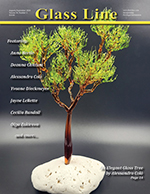
|
In This Issue
Stud Earrings — Flat Circles by Yvonne Dieckmeyer
I discovered glass in 1997. I had taken a Tiffany course with Eva-Marie Volkmann and was fascinated by stained glass. One of the Volkmanns’ employees came to me one evening and told me about the possibility of melting glass with a burner and then shaping it into a ball on a mandrel.
I wasn’t very keen about making glass beads. I didn’t know anything about making round marbles. There were no pictures, no other artists, no web; I had no visual templates. Then Marlies started the burner and formed a glass ball on a spike, and since then, I’ve been infected and always on the lookout for my own ideas. The better you know the techniques of glass processing, the easier it is to go your own way, and that’s what I do...

In addition to working as a flameworker, I also studied art history. The combination of craftsmanship and historical backgrounds is particularly gratifying. Historic ornaments or works of art often inspire my own creations. My other, and perhaps even greater, source of inspiration is nature. Natural light effects are particularly fascinating, and that is why I often try to capture them in my glass works.
I am pleased to be writing a third tutorial for Glass Line in addition to two previous ones, which have been about a Lattice Technique Elephant (April/May 2022) and a Twisted Bead (February/March 2023). This tutorial is about an object in which many of my sources of inspiration merge. The traditional heart-shaped ornament, which plays an important role in both Alpine culture and Venetian glass bead production, is highlighted by its colorlessness. The pattern allows a view right through the bead, as well as an internal view in a different color than the surface. The incidence of light, which is possible from all sides, makes the bead shine from within. Depending on the color chosen, it comes quite close to sunlight...

Having always being attracted by sculpture, I attended a course with Maestro Mauro Vianello in Venice. That was a further and significant step forward — sculpting allows absolute freedom and the possibility of expressing fantasy and imagination, experimenting, and refining new techniques. My idea, my artistic intent, is being able to abstract, conceptualize the subjects of my works.
This tutorial captures the elegance, wisdom, and peacefulness that a tree transmits through one made with soft glass, trying to crystallize these sensations, through an expressionist conception of shape and color...

I have since then been lucky enough to build up a little studio in my garage. I consider myself a glass hobbyist. There are so many glass artists who I hope to one day be close to as good as; while I am not there yet, I keep playing and having fun with the flame and glass and learning. That, in itself, makes me very happy. Most of what I make has been for fun and for myself, with the occasional Etsy listing because I’ve made more items than I know what to do with. Lately, I have been trying to sell more, doing makers’ markets and trying to get myself more out there. I always look forward to learning more glass skills and love to share the joy glass brings me with others.
This tutorial is about how to make a glass goddess (female body figure) pendant. This project is so much fun. Something I love about it is that every body is different, so every piece can be a little different from any others. Since it’s an organic figure, it also doesn’t have to be perfectly symmetrical. You don’t have to worry about perfection and can just have fun, and know that if your piece turns out perfectly imperfect, that is ... perfect...

Glass ... can be so diverse ... It can be brutal and tender, monumental and sophisticated. And what can be prettier than flowers? We celebrate love, new life, achievements, and memorable moments in life with flowers. I wish I could give flowers to every one of my customers for every occasion in their lives, because by observing nice things, we water the flowers growing within ourselves and the job of art is to create such feelings.
This is my technique for creating flower murrini and a spherical bead...

After a few years of enjoying — but not entirely loving — furnace working, I found out about the Corning Museum of Glass and their studio, where I signed up for an introduction to borosilicate glass class, and I’ve been having fun with it ever since.
I have always been captivated by ocean waves, and I view their constant state of flow and movement as a metaphor for life. Much like the sea, our lives will become stormy and turbulent at times, and giant waves may even knock us down for a while, but they eventually recede, which in turn gives way to calmer tides. This philosophy is what I intend to convey with these wave pendants. Much like real ocean waves, no two ever turn out the same. You don’t have to worry about being too technical; feel free to play around with color and style — I sure do! Thank you for taking the time to read my story and I hope you enjoy making these as much as I do...

I’ve made sparkle, patterned, and glow-in-the-dark bead caps recently. I rivet the caps in place by hand, without using any special coring tools, and I find the process very relaxing. I think most glass is so pretty that it speaks for itself. Touches of dichroic or glow glass can add extra interest and dimension to the beads.
One of my favorite styles of beads is a textured wave made with an Effetre color of choice, a silvered glass, and clear. It’s a simple bead to make and uses just a couple tools that many people would have lying around the house. Taking notes of the different color combinations helps so the prettiest outcomes can be somewhat duplicated. I experiment a lot, so opening the kiln after annealing is always a surprise. There can be some really gorgeous beads and some disgustingly ugly beads as well, but that’s the fun of it...
|
 June/July 2024 - Vol. 38, No. 1.
June/July 2024 - Vol. 38, No. 1.

|
In This Issue
How to Make Core Glass by Akiko Furuki
I live in Japan.
“Core glass” is the world’s oldest glassware-forming technique. It is an ancient technique that evolved during the ancient Mesopotamian and Egyptian dynasties. It is believed to be between approximately 3,500 and 1,500 years old.
By 2,000 years later (1st century BC), when the technique of blown glass was established, it was a forgotten technique in history—but the technique has been reconstructed by a very great contemporary artist, Mr. Iwao Matushima. I believe that he and this technique connect the ancients with us today...

I live in Nizhniy Novgorod, Russia. I started lampworking in 2013 after I’d left my office job as an English translator. As a child, I was always attracted to anything handmade and tried different hobbies and activities, but I always believed that I was too clumsy to make something beautiful with my hands and I envied people who could do that.
Then I came to know lampworking. That completely blew my mind and changed my life. Finally, I found a material suitable for my creativity! I was inspired, with thousands of ideas that I wanted to realize. Sometimes I couldn’t even sleep because of that.
I left my office job after a complete burnout and started making glass beads and jewelry. Of course, many people thought I was crazy to do that — but here I am today, 10 years later, still making glass beads. This tutorial is to share my passion for glass and show one of my designs...

I usually think up a design first and then try to find the right way to create it. Sometimes I realize I came up with something that just can’t be made, but usually I just keep trying until I make it. It fascinates me that unlike other material, glass allows you to work with layers to create a motif within. That’s what I focus on: layers, progression, building a theme step by step.
In my mind, this piece what an autumn storm looks like. The idea was born when I was listening to Vivaldi’s interpretation of a storm, which is actually the final movement, Presto (in G minor), of summer in “The Four Seasons.” However, I wanted to make a colorful bead, so I set the scene in the fall.
Note: In this Tutorial I use hard glass to explain...

In this article I want to share the elegance of copper electroforming. I will touch on the varied and numerous ways I use electroforming to create unique pieces of art and I will explain the process and science of electroforming to help you get started. If you are interested in exploring these techniques in more depth, I am offering a series of electroforming classes through Zurich Glass Schoo...
Landscape Bead by Blake Mazzei
I love making landscape beads that explore different ideas. It’s always an experiment.
I have developed these general rules for my work: I use the same number of opaque colored rods as transparent colored rods, working from the darkest colors to the lightest ones, making it as irregular as possible; I alternate opaque and transparent colors, while doubling the amount of transparent colors. Then I encase the bead with clear glass to give more depth.
...

I was born in a small town in the south of Russia and never thought that one day, I would work with glass. I live in Moscow now. I graduated from the Moscow State University of Prints and am a graphic designer (book illustrator) by education.
It’s a bit of a funny story. I tried so hard to get there — I took exams three times and was finally successful only after three years of attempts, but in the last year of university, I figured out that I didn’t want to be a book illustrator. However, this experience showed me that I can be really stubborn in reaching my goals. The thing is to choose the right goal!
For a few years, I rented a studio with friends, but the year 2020 changed all that, of course. QR codes in Moscow allowed us to go outside only twice a week, which meant that I could not work in my rented workshop anymore, so I decided to move to my home studio. The pandemic made me want to fill my life with beauty and love even more than before.
I live in a small apartment and my studio is tiny but comfortable. It lets me work on the torch at any time...
|
 April/May, 2024 - Vol. 37, No. 6.
April/May, 2024 - Vol. 37, No. 6.
|

